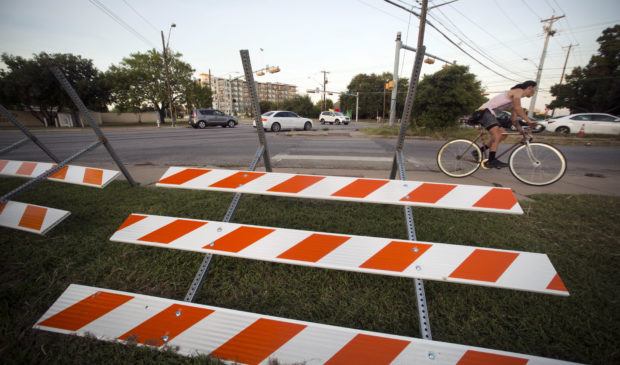Could the mayor’s ‘Go Big’ bond go bigger?
Thursday, August 18, 2016 by
Audrey McGlinchy, KUT Mayor Steve Adler has christened the $720 million transportation bond as the “Go Big Corridor Plan,” which prompts the question: Is this really that big? Seattle recently placed on a ballot a $54 billion transportation bond. Still, judging by other news reports, a number that large seems like an anomaly among municipal bond programs.
Regardless, there’s plenty to unpack when we discuss the “bigness” of this bond. First, there’s the impact to taxpayers.
What will this do to my property taxes?
Under the current proposal, city staff estimates that the average homeowner – with a house worth $250,000 – would see a property tax increase of $4.67 a month, or $56 a year. Compare that to the failed rail bond in 2014, which would have impacted taxpayers’ bills at a rate nearly four times that.
Notably, should voters approve the $720 million bond, taxpayers would not feel that additional burden until 2018.
What is the money paying for?
Most of the bond money ($482 million) would go toward eight (or nine) major roads in Austin – including North Lamar Boulevard, South Lamar Boulevard, Burnet Road, Martin Luther King Jr. Boulevard/FM 969, Guadalupe Street, East Riverside Drive, Airport Boulevard, William Cannon Drive and/or Slaughter Lane.
The remaining $238 million would be spread out among a variety of other projects, including the Sidewalk Master Plan and the Urban Trails Master Plan.
For a comprehensive breakdown, check out our story from last week, complete with a map and photos of each corridor.
Could we go bigger?
Yes. That could happen in two ways. First, there’s the option to “go bigger” by raising taxes. State law allows “home rule” cities, such as Austin, to set property taxes as high as $2.50 per $100 valuation (the current proposed rate is 44 cents per $100 valuation). But, getting there would most likely trigger a public vote.
Then, there’s the option to “go bigger” without raising taxes any further. In that case, Austin could go up to $250 million bigger. That figure takes into account Austin’s bond capacity. Think of it as a car payment – if you’re a smart budgeter, your monthly car payment is exactly what you can afford assuming your salary remains stagnant.
The city does the same. Currently, it assumes $500 million is what it can afford in bonds given current property tax revenue (part of the city’s salary, if you will). In other words, that’s the bond amount the city could afford before it were forced to hike property taxes.
Adler has diverted $250 million of that bond capacity into the $720 million dollar bond. So the remaining $470 million dollars is why property taxes would be raised. So, in theory we could divert all of our bond capacity to this transportation bond – getting us to a nearly $1 billion bond without tax hikes beyond what is already proposed. But that brings us to this next question.
Should we go bigger?
The mayor would like to.
“The bond could have been bigger, and frankly I think the bond should have been bigger to deal with the challenges we have,” Adler told the Austin Monitor. He said perceived consensus, future bond capacity and the effect on property taxes all limited the amount.
During last week’s Council meeting, Adler indicated that this bond money could be the beginning of focused spending on transportation.
“If we can actually take this money and spend it strategically, we can actually move forward to support Capital Metro and turn this into a city where that’s a viable choice for people to make,” said Adler. “And if we can actually start it and increase ridership, then it’ll be able to snowball and build on itself, and we’ll be able to build more routes in more places for more people.”
And then there are some people who feel the money has not been prioritized well – that we could spend more, or at least allocate, the $720 million differently. For example, the city’s Sidewalk Master Plan (Council members approved an updated version in June) aims to build 390 new miles of sidewalk over 10 years at an estimated cost of $250 million. Council members have dedicated $37.5 million of the $720 million to the plan.
Tom Wald, a member of the city’s Pedestrian Advisory Council, testified at the Council meeting last week. “It’s not a matter of these corridor projects being bad,” Wald told KUT, noting where most of the bond money will go. “It’s more of, what order do we prioritize our funding and in what order does that play out?”
How will this affect future bond proposals?
Some Council members have worried about the limits a $720 million bond places on future bonds and the city’s capacity to fund things other than transportation. It most likely means that if we want to issue a bond totaling more than $250 million in the future, there will have to be another tax increase.
Photo by Gabriel Cristóver Pérez/KUT. This story was produced as part of the Austin Monitor’s reporting partnership with KUT.
The Monitor’s work is made possible by donations from the community. Though our reporting covers donors from time to time, we are careful to keep business and editorial efforts separate while maintaining transparency. A complete list of donors is available here, and our code of ethics is explained here.
You're a community leader
And we’re honored you look to us for serious, in-depth news. You know a strong community needs local and dedicated watchdog reporting. We’re here for you and that won’t change. Now will you take the powerful next step and support our nonprofit news organization?



